Edexcel BTEC Strategic Change Management Report - Unit 10
VerifiedAdded on 2020/01/15
|13
|3381
|119
Report
AI Summary
This report examines strategic change management within Framlington Property Plc, a UK-based public company planning expansion into India and China. The analysis begins with stakeholder identification, including employees, government, investors, and others, and proposes strategies for their involvement in change planning, such as using forums, open communication, and training programs. The report evaluates systems used to involve stakeholders, including a six-step stakeholder circle approach. It also develops strategies for managing and overcoming resistance to change, differentiating between active and passive resistance. Furthermore, the report explores appropriate change models, specifically the John P. Kotter model, and outlines implementation plans and monitoring measures to assess the progress of change initiatives. The report emphasizes the importance of stakeholder engagement and proactive management to ensure successful strategic change within the organization.
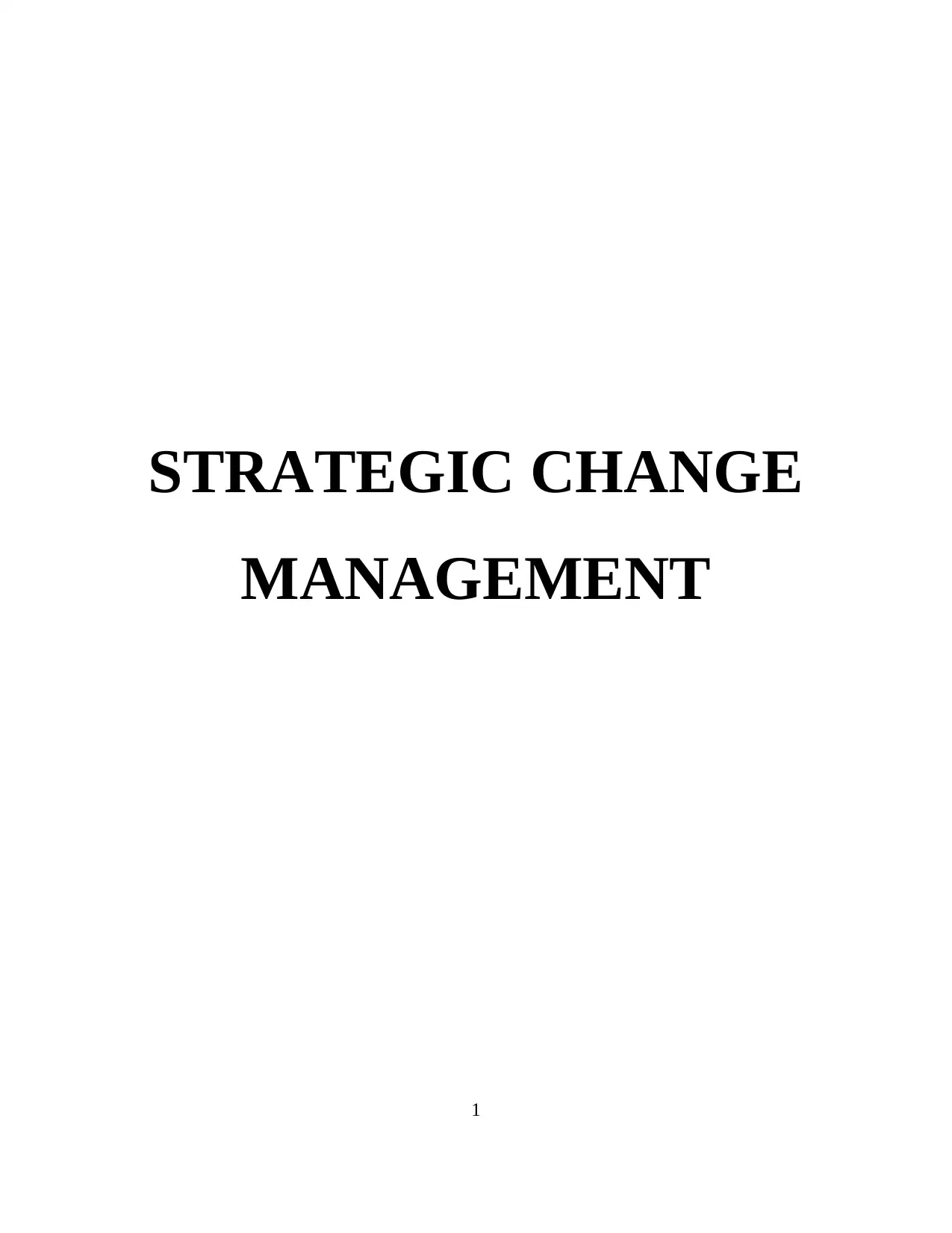
STRATEGIC CHANGE
MANAGEMENT
1
MANAGEMENT
1
Paraphrase This Document
Need a fresh take? Get an instant paraphrase of this document with our AI Paraphraser
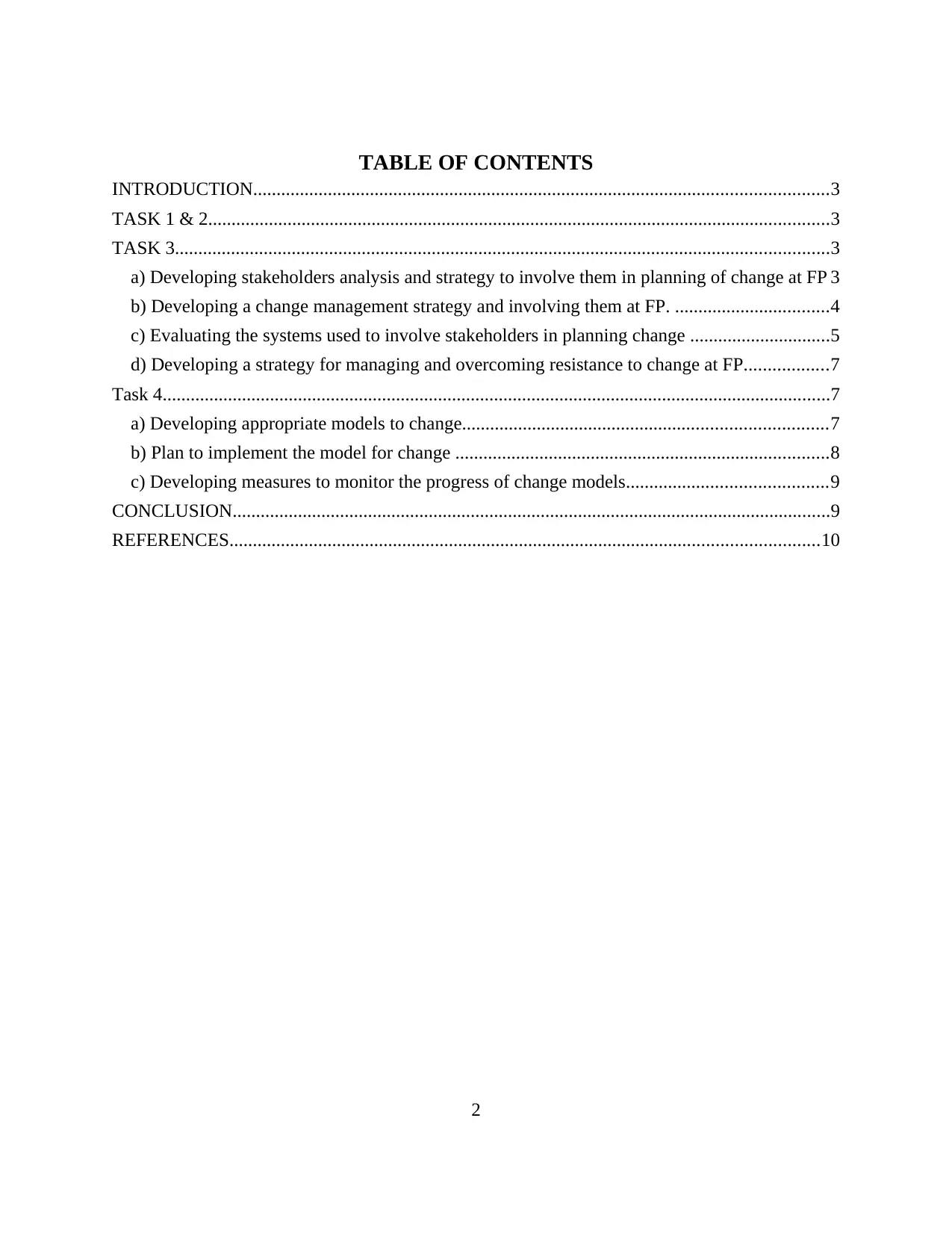
TABLE OF CONTENTS
INTRODUCTION...........................................................................................................................3
TASK 1 & 2.....................................................................................................................................3
TASK 3............................................................................................................................................3
a) Developing stakeholders analysis and strategy to involve them in planning of change at FP 3
b) Developing a change management strategy and involving them at FP. .................................4
c) Evaluating the systems used to involve stakeholders in planning change ..............................5
d) Developing a strategy for managing and overcoming resistance to change at FP..................7
Task 4...............................................................................................................................................7
a) Developing appropriate models to change..............................................................................7
b) Plan to implement the model for change ................................................................................8
c) Developing measures to monitor the progress of change models...........................................9
CONCLUSION................................................................................................................................9
REFERENCES..............................................................................................................................10
2
INTRODUCTION...........................................................................................................................3
TASK 1 & 2.....................................................................................................................................3
TASK 3............................................................................................................................................3
a) Developing stakeholders analysis and strategy to involve them in planning of change at FP 3
b) Developing a change management strategy and involving them at FP. .................................4
c) Evaluating the systems used to involve stakeholders in planning change ..............................5
d) Developing a strategy for managing and overcoming resistance to change at FP..................7
Task 4...............................................................................................................................................7
a) Developing appropriate models to change..............................................................................7
b) Plan to implement the model for change ................................................................................8
c) Developing measures to monitor the progress of change models...........................................9
CONCLUSION................................................................................................................................9
REFERENCES..............................................................................................................................10
2
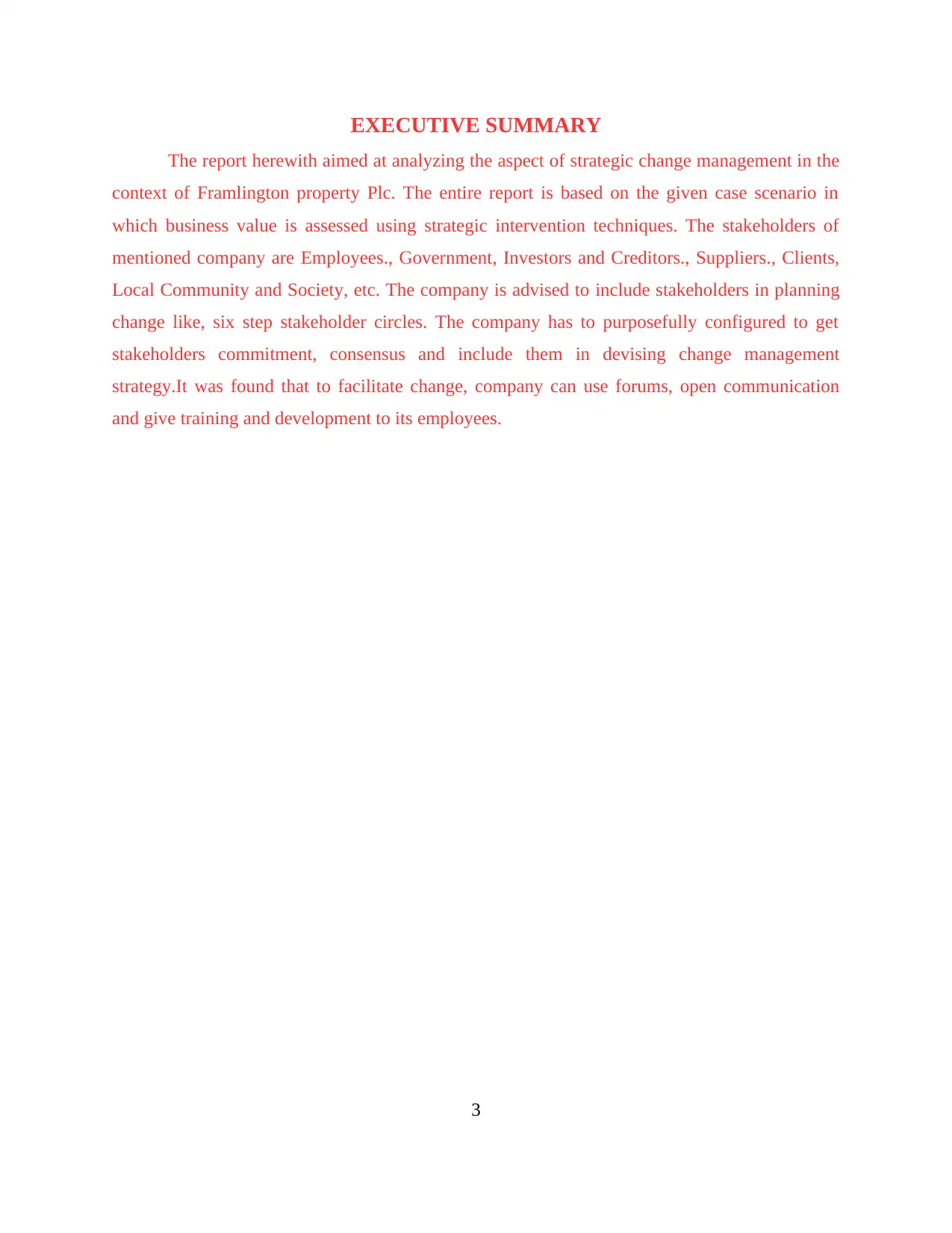
EXECUTIVE SUMMARY
The report herewith aimed at analyzing the aspect of strategic change management in the
context of Framlington property Plc. The entire report is based on the given case scenario in
which business value is assessed using strategic intervention techniques. The stakeholders of
mentioned company are Employees., Government, Investors and Creditors., Suppliers., Clients,
Local Community and Society, etc. The company is advised to include stakeholders in planning
change like, six step stakeholder circles. The company has to purposefully configured to get
stakeholders commitment, consensus and include them in devising change management
strategy.It was found that to facilitate change, company can use forums, open communication
and give training and development to its employees.
3
The report herewith aimed at analyzing the aspect of strategic change management in the
context of Framlington property Plc. The entire report is based on the given case scenario in
which business value is assessed using strategic intervention techniques. The stakeholders of
mentioned company are Employees., Government, Investors and Creditors., Suppliers., Clients,
Local Community and Society, etc. The company is advised to include stakeholders in planning
change like, six step stakeholder circles. The company has to purposefully configured to get
stakeholders commitment, consensus and include them in devising change management
strategy.It was found that to facilitate change, company can use forums, open communication
and give training and development to its employees.
3
⊘ This is a preview!⊘
Do you want full access?
Subscribe today to unlock all pages.

Trusted by 1+ million students worldwide
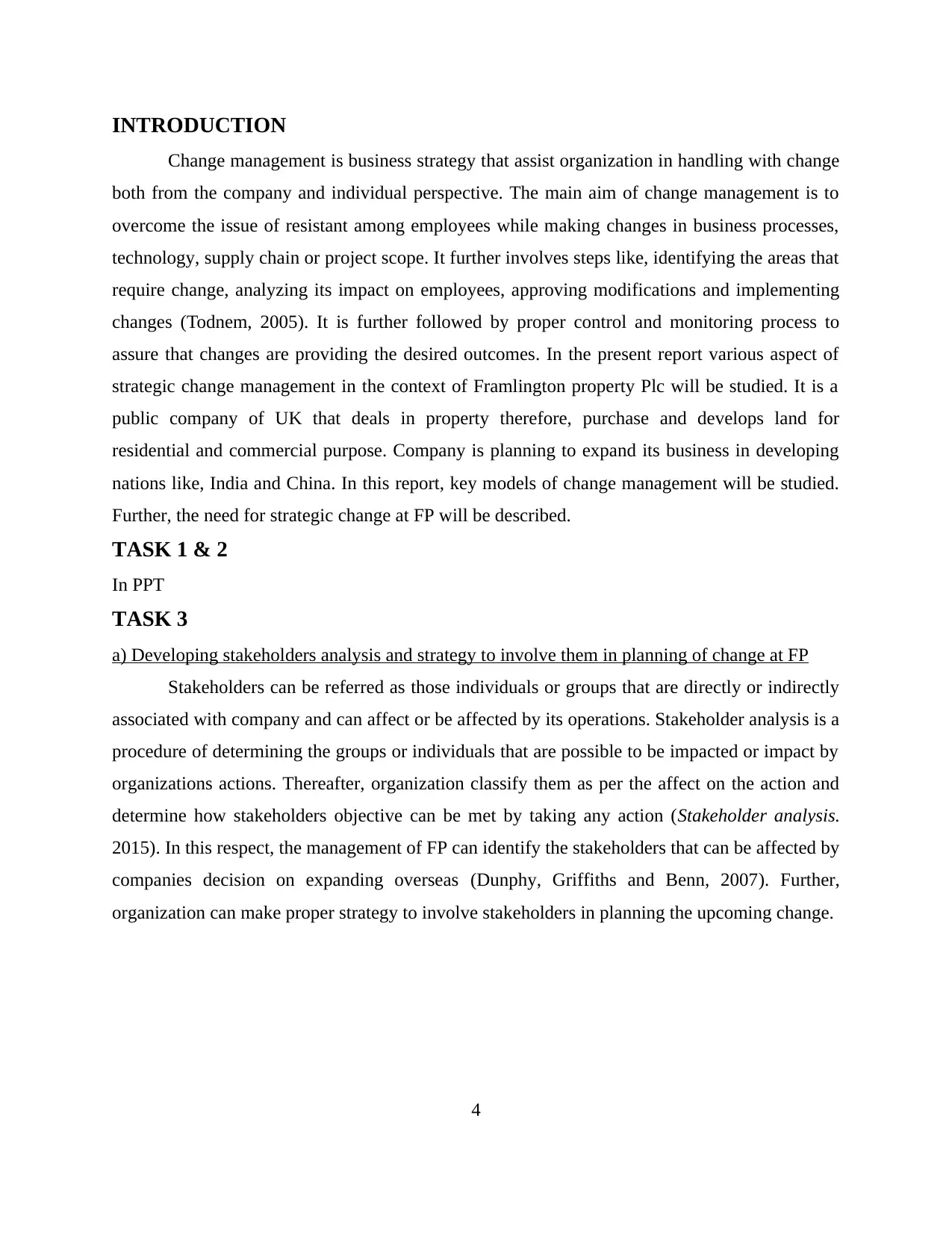
INTRODUCTION
Change management is business strategy that assist organization in handling with change
both from the company and individual perspective. The main aim of change management is to
overcome the issue of resistant among employees while making changes in business processes,
technology, supply chain or project scope. It further involves steps like, identifying the areas that
require change, analyzing its impact on employees, approving modifications and implementing
changes (Todnem, 2005). It is further followed by proper control and monitoring process to
assure that changes are providing the desired outcomes. In the present report various aspect of
strategic change management in the context of Framlington property Plc will be studied. It is a
public company of UK that deals in property therefore, purchase and develops land for
residential and commercial purpose. Company is planning to expand its business in developing
nations like, India and China. In this report, key models of change management will be studied.
Further, the need for strategic change at FP will be described.
TASK 1 & 2
In PPT
TASK 3
a) Developing stakeholders analysis and strategy to involve them in planning of change at FP
Stakeholders can be referred as those individuals or groups that are directly or indirectly
associated with company and can affect or be affected by its operations. Stakeholder analysis is a
procedure of determining the groups or individuals that are possible to be impacted or impact by
organizations actions. Thereafter, organization classify them as per the affect on the action and
determine how stakeholders objective can be met by taking any action (Stakeholder analysis.
2015). In this respect, the management of FP can identify the stakeholders that can be affected by
companies decision on expanding overseas (Dunphy, Griffiths and Benn, 2007). Further,
organization can make proper strategy to involve stakeholders in planning the upcoming change.
4
Change management is business strategy that assist organization in handling with change
both from the company and individual perspective. The main aim of change management is to
overcome the issue of resistant among employees while making changes in business processes,
technology, supply chain or project scope. It further involves steps like, identifying the areas that
require change, analyzing its impact on employees, approving modifications and implementing
changes (Todnem, 2005). It is further followed by proper control and monitoring process to
assure that changes are providing the desired outcomes. In the present report various aspect of
strategic change management in the context of Framlington property Plc will be studied. It is a
public company of UK that deals in property therefore, purchase and develops land for
residential and commercial purpose. Company is planning to expand its business in developing
nations like, India and China. In this report, key models of change management will be studied.
Further, the need for strategic change at FP will be described.
TASK 1 & 2
In PPT
TASK 3
a) Developing stakeholders analysis and strategy to involve them in planning of change at FP
Stakeholders can be referred as those individuals or groups that are directly or indirectly
associated with company and can affect or be affected by its operations. Stakeholder analysis is a
procedure of determining the groups or individuals that are possible to be impacted or impact by
organizations actions. Thereafter, organization classify them as per the affect on the action and
determine how stakeholders objective can be met by taking any action (Stakeholder analysis.
2015). In this respect, the management of FP can identify the stakeholders that can be affected by
companies decision on expanding overseas (Dunphy, Griffiths and Benn, 2007). Further,
organization can make proper strategy to involve stakeholders in planning the upcoming change.
4
Paraphrase This Document
Need a fresh take? Get an instant paraphrase of this document with our AI Paraphraser
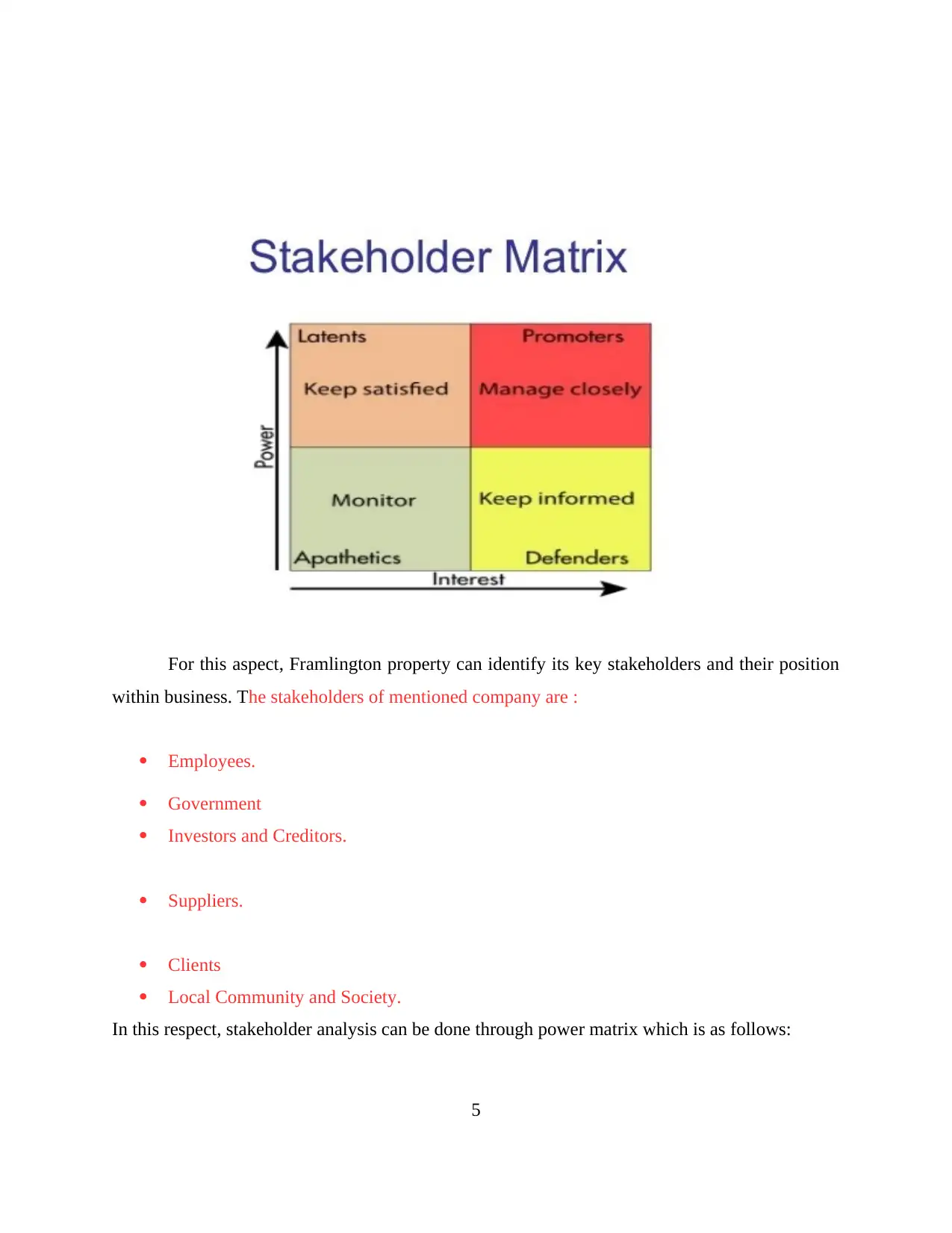
For this aspect, Framlington property can identify its key stakeholders and their position
within business. The stakeholders of mentioned company are :
Employees.
Government
Investors and Creditors.
Suppliers.
Clients
Local Community and Society.
In this respect, stakeholder analysis can be done through power matrix which is as follows:
5
within business. The stakeholders of mentioned company are :
Employees.
Government
Investors and Creditors.
Suppliers.
Clients
Local Community and Society.
In this respect, stakeholder analysis can be done through power matrix which is as follows:
5
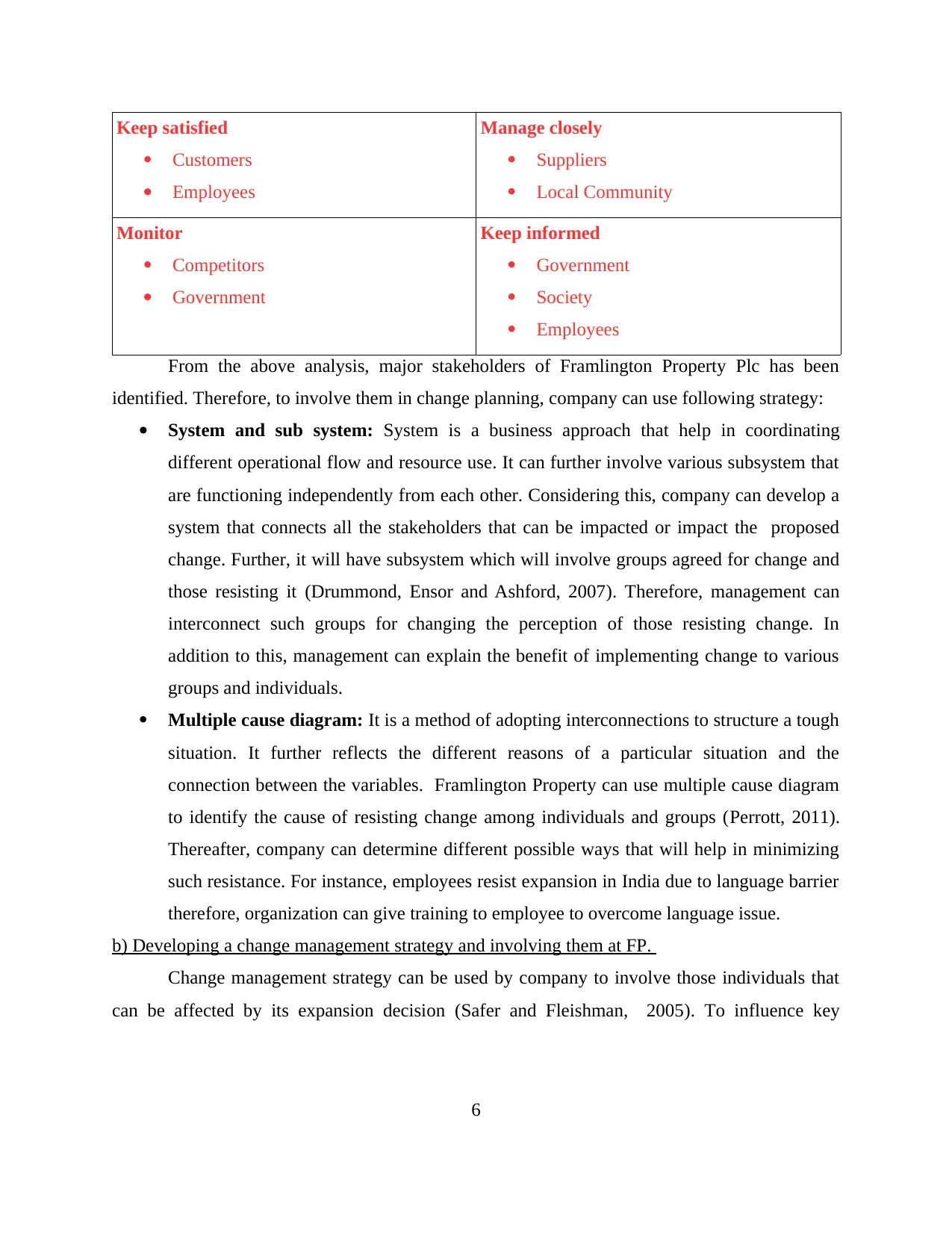
Keep satisfied
Customers
Employees
Manage closely
Suppliers
Local Community
Monitor
Competitors
Government
Keep informed
Government
Society
Employees
From the above analysis, major stakeholders of Framlington Property Plc has been
identified. Therefore, to involve them in change planning, company can use following strategy:
System and sub system: System is a business approach that help in coordinating
different operational flow and resource use. It can further involve various subsystem that
are functioning independently from each other. Considering this, company can develop a
system that connects all the stakeholders that can be impacted or impact the proposed
change. Further, it will have subsystem which will involve groups agreed for change and
those resisting it (Drummond, Ensor and Ashford, 2007). Therefore, management can
interconnect such groups for changing the perception of those resisting change. In
addition to this, management can explain the benefit of implementing change to various
groups and individuals.
Multiple cause diagram: It is a method of adopting interconnections to structure a tough
situation. It further reflects the different reasons of a particular situation and the
connection between the variables. Framlington Property can use multiple cause diagram
to identify the cause of resisting change among individuals and groups (Perrott, 2011).
Thereafter, company can determine different possible ways that will help in minimizing
such resistance. For instance, employees resist expansion in India due to language barrier
therefore, organization can give training to employee to overcome language issue.
b) Developing a change management strategy and involving them at FP.
Change management strategy can be used by company to involve those individuals that
can be affected by its expansion decision (Safer and Fleishman, 2005). To influence key
6
Customers
Employees
Manage closely
Suppliers
Local Community
Monitor
Competitors
Government
Keep informed
Government
Society
Employees
From the above analysis, major stakeholders of Framlington Property Plc has been
identified. Therefore, to involve them in change planning, company can use following strategy:
System and sub system: System is a business approach that help in coordinating
different operational flow and resource use. It can further involve various subsystem that
are functioning independently from each other. Considering this, company can develop a
system that connects all the stakeholders that can be impacted or impact the proposed
change. Further, it will have subsystem which will involve groups agreed for change and
those resisting it (Drummond, Ensor and Ashford, 2007). Therefore, management can
interconnect such groups for changing the perception of those resisting change. In
addition to this, management can explain the benefit of implementing change to various
groups and individuals.
Multiple cause diagram: It is a method of adopting interconnections to structure a tough
situation. It further reflects the different reasons of a particular situation and the
connection between the variables. Framlington Property can use multiple cause diagram
to identify the cause of resisting change among individuals and groups (Perrott, 2011).
Thereafter, company can determine different possible ways that will help in minimizing
such resistance. For instance, employees resist expansion in India due to language barrier
therefore, organization can give training to employee to overcome language issue.
b) Developing a change management strategy and involving them at FP.
Change management strategy can be used by company to involve those individuals that
can be affected by its expansion decision (Safer and Fleishman, 2005). To influence key
6
⊘ This is a preview!⊘
Do you want full access?
Subscribe today to unlock all pages.

Trusted by 1+ million students worldwide
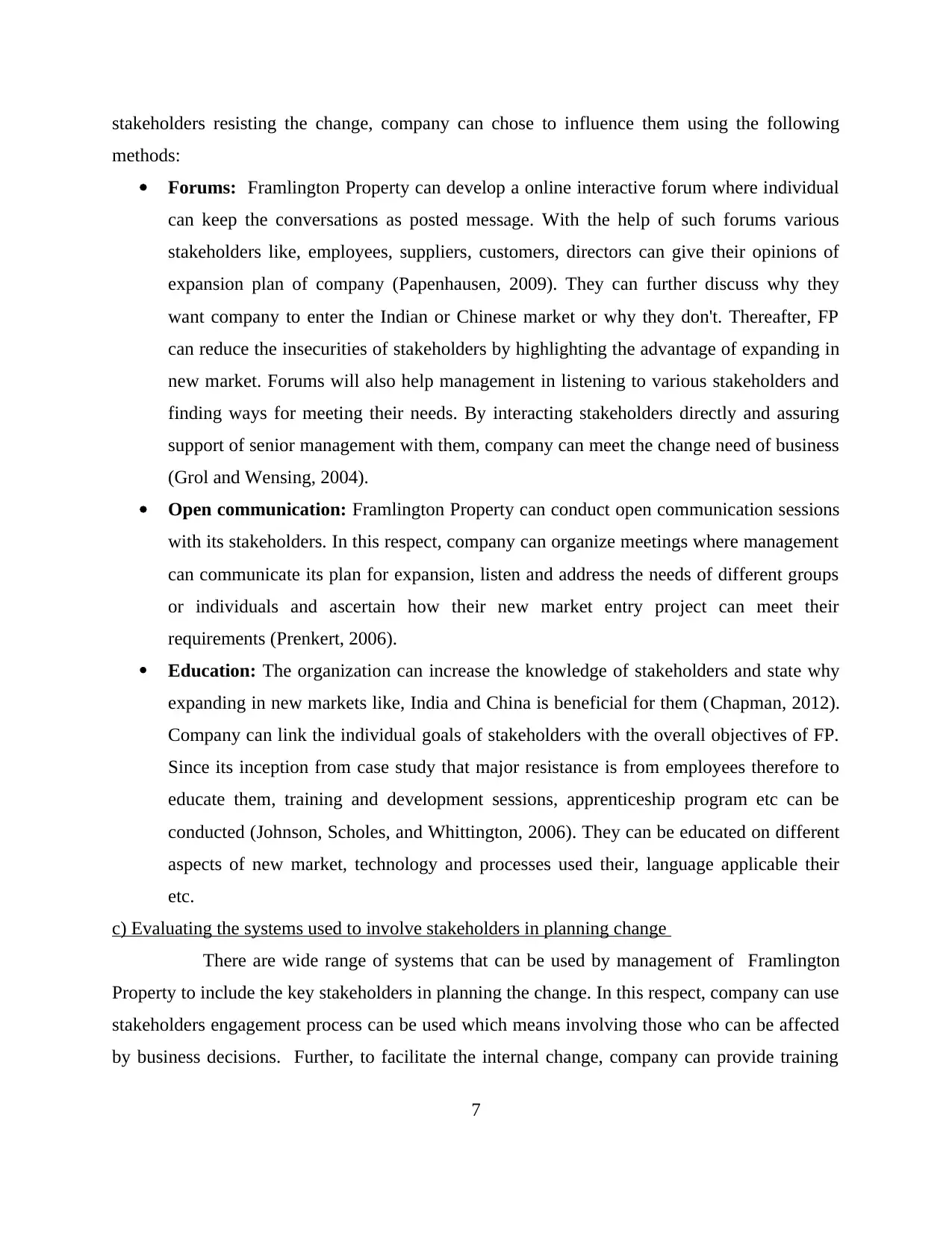
stakeholders resisting the change, company can chose to influence them using the following
methods:
Forums: Framlington Property can develop a online interactive forum where individual
can keep the conversations as posted message. With the help of such forums various
stakeholders like, employees, suppliers, customers, directors can give their opinions of
expansion plan of company (Papenhausen, 2009). They can further discuss why they
want company to enter the Indian or Chinese market or why they don't. Thereafter, FP
can reduce the insecurities of stakeholders by highlighting the advantage of expanding in
new market. Forums will also help management in listening to various stakeholders and
finding ways for meeting their needs. By interacting stakeholders directly and assuring
support of senior management with them, company can meet the change need of business
(Grol and Wensing, 2004).
Open communication: Framlington Property can conduct open communication sessions
with its stakeholders. In this respect, company can organize meetings where management
can communicate its plan for expansion, listen and address the needs of different groups
or individuals and ascertain how their new market entry project can meet their
requirements (Prenkert, 2006).
Education: The organization can increase the knowledge of stakeholders and state why
expanding in new markets like, India and China is beneficial for them (Chapman, 2012).
Company can link the individual goals of stakeholders with the overall objectives of FP.
Since its inception from case study that major resistance is from employees therefore to
educate them, training and development sessions, apprenticeship program etc can be
conducted (Johnson, Scholes, and Whittington, 2006). They can be educated on different
aspects of new market, technology and processes used their, language applicable their
etc.
c) Evaluating the systems used to involve stakeholders in planning change
There are wide range of systems that can be used by management of Framlington
Property to include the key stakeholders in planning the change. In this respect, company can use
stakeholders engagement process can be used which means involving those who can be affected
by business decisions. Further, to facilitate the internal change, company can provide training
7
methods:
Forums: Framlington Property can develop a online interactive forum where individual
can keep the conversations as posted message. With the help of such forums various
stakeholders like, employees, suppliers, customers, directors can give their opinions of
expansion plan of company (Papenhausen, 2009). They can further discuss why they
want company to enter the Indian or Chinese market or why they don't. Thereafter, FP
can reduce the insecurities of stakeholders by highlighting the advantage of expanding in
new market. Forums will also help management in listening to various stakeholders and
finding ways for meeting their needs. By interacting stakeholders directly and assuring
support of senior management with them, company can meet the change need of business
(Grol and Wensing, 2004).
Open communication: Framlington Property can conduct open communication sessions
with its stakeholders. In this respect, company can organize meetings where management
can communicate its plan for expansion, listen and address the needs of different groups
or individuals and ascertain how their new market entry project can meet their
requirements (Prenkert, 2006).
Education: The organization can increase the knowledge of stakeholders and state why
expanding in new markets like, India and China is beneficial for them (Chapman, 2012).
Company can link the individual goals of stakeholders with the overall objectives of FP.
Since its inception from case study that major resistance is from employees therefore to
educate them, training and development sessions, apprenticeship program etc can be
conducted (Johnson, Scholes, and Whittington, 2006). They can be educated on different
aspects of new market, technology and processes used their, language applicable their
etc.
c) Evaluating the systems used to involve stakeholders in planning change
There are wide range of systems that can be used by management of Framlington
Property to include the key stakeholders in planning the change. In this respect, company can use
stakeholders engagement process can be used which means involving those who can be affected
by business decisions. Further, to facilitate the internal change, company can provide training
7
Paraphrase This Document
Need a fresh take? Get an instant paraphrase of this document with our AI Paraphraser
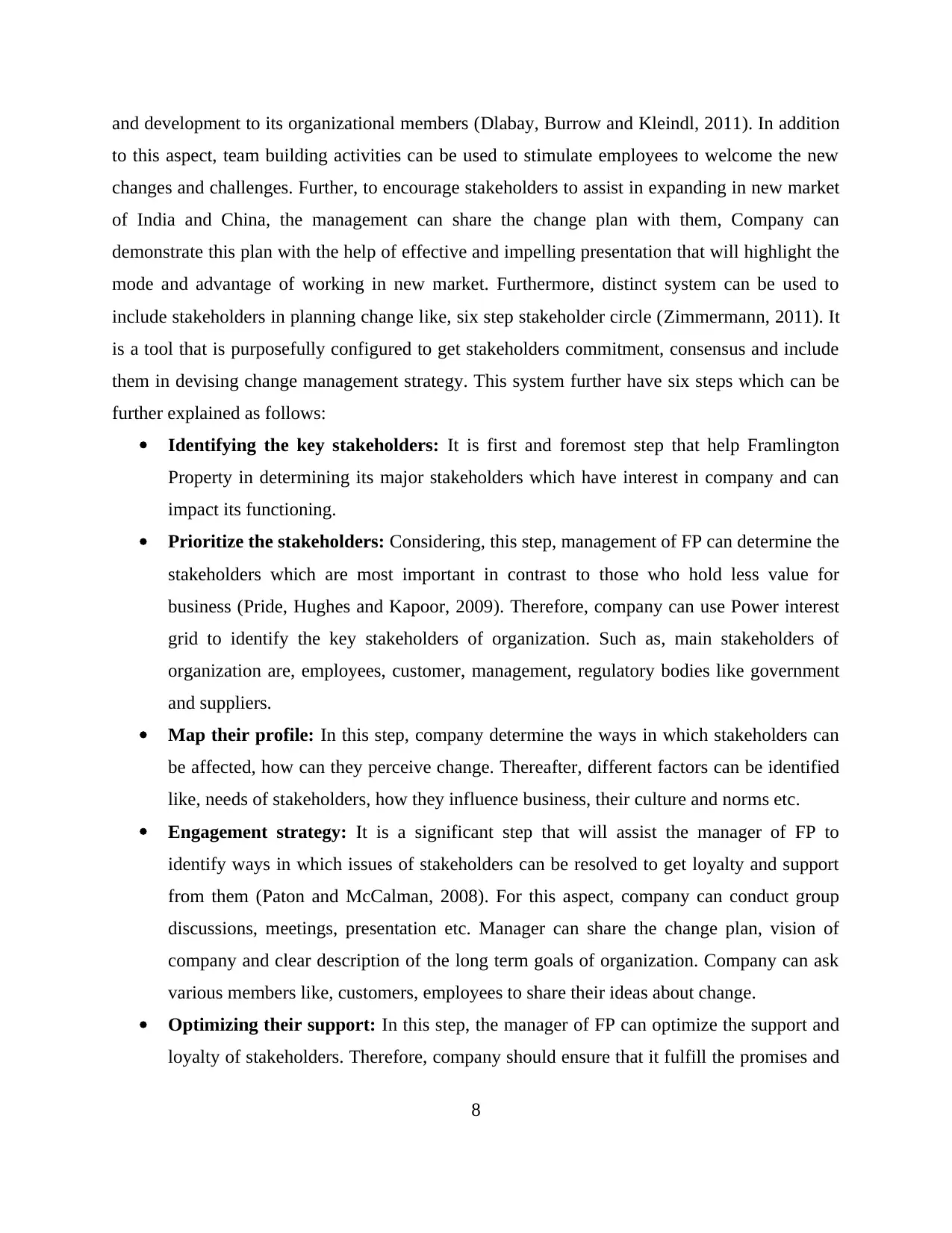
and development to its organizational members (Dlabay, Burrow and Kleindl, 2011). In addition
to this aspect, team building activities can be used to stimulate employees to welcome the new
changes and challenges. Further, to encourage stakeholders to assist in expanding in new market
of India and China, the management can share the change plan with them, Company can
demonstrate this plan with the help of effective and impelling presentation that will highlight the
mode and advantage of working in new market. Furthermore, distinct system can be used to
include stakeholders in planning change like, six step stakeholder circle (Zimmermann, 2011). It
is a tool that is purposefully configured to get stakeholders commitment, consensus and include
them in devising change management strategy. This system further have six steps which can be
further explained as follows:
Identifying the key stakeholders: It is first and foremost step that help Framlington
Property in determining its major stakeholders which have interest in company and can
impact its functioning.
Prioritize the stakeholders: Considering, this step, management of FP can determine the
stakeholders which are most important in contrast to those who hold less value for
business (Pride, Hughes and Kapoor, 2009). Therefore, company can use Power interest
grid to identify the key stakeholders of organization. Such as, main stakeholders of
organization are, employees, customer, management, regulatory bodies like government
and suppliers.
Map their profile: In this step, company determine the ways in which stakeholders can
be affected, how can they perceive change. Thereafter, different factors can be identified
like, needs of stakeholders, how they influence business, their culture and norms etc.
Engagement strategy: It is a significant step that will assist the manager of FP to
identify ways in which issues of stakeholders can be resolved to get loyalty and support
from them (Paton and McCalman, 2008). For this aspect, company can conduct group
discussions, meetings, presentation etc. Manager can share the change plan, vision of
company and clear description of the long term goals of organization. Company can ask
various members like, customers, employees to share their ideas about change.
Optimizing their support: In this step, the manager of FP can optimize the support and
loyalty of stakeholders. Therefore, company should ensure that it fulfill the promises and
8
to this aspect, team building activities can be used to stimulate employees to welcome the new
changes and challenges. Further, to encourage stakeholders to assist in expanding in new market
of India and China, the management can share the change plan with them, Company can
demonstrate this plan with the help of effective and impelling presentation that will highlight the
mode and advantage of working in new market. Furthermore, distinct system can be used to
include stakeholders in planning change like, six step stakeholder circle (Zimmermann, 2011). It
is a tool that is purposefully configured to get stakeholders commitment, consensus and include
them in devising change management strategy. This system further have six steps which can be
further explained as follows:
Identifying the key stakeholders: It is first and foremost step that help Framlington
Property in determining its major stakeholders which have interest in company and can
impact its functioning.
Prioritize the stakeholders: Considering, this step, management of FP can determine the
stakeholders which are most important in contrast to those who hold less value for
business (Pride, Hughes and Kapoor, 2009). Therefore, company can use Power interest
grid to identify the key stakeholders of organization. Such as, main stakeholders of
organization are, employees, customer, management, regulatory bodies like government
and suppliers.
Map their profile: In this step, company determine the ways in which stakeholders can
be affected, how can they perceive change. Thereafter, different factors can be identified
like, needs of stakeholders, how they influence business, their culture and norms etc.
Engagement strategy: It is a significant step that will assist the manager of FP to
identify ways in which issues of stakeholders can be resolved to get loyalty and support
from them (Paton and McCalman, 2008). For this aspect, company can conduct group
discussions, meetings, presentation etc. Manager can share the change plan, vision of
company and clear description of the long term goals of organization. Company can ask
various members like, customers, employees to share their ideas about change.
Optimizing their support: In this step, the manager of FP can optimize the support and
loyalty of stakeholders. Therefore, company should ensure that it fulfill the promises and
8
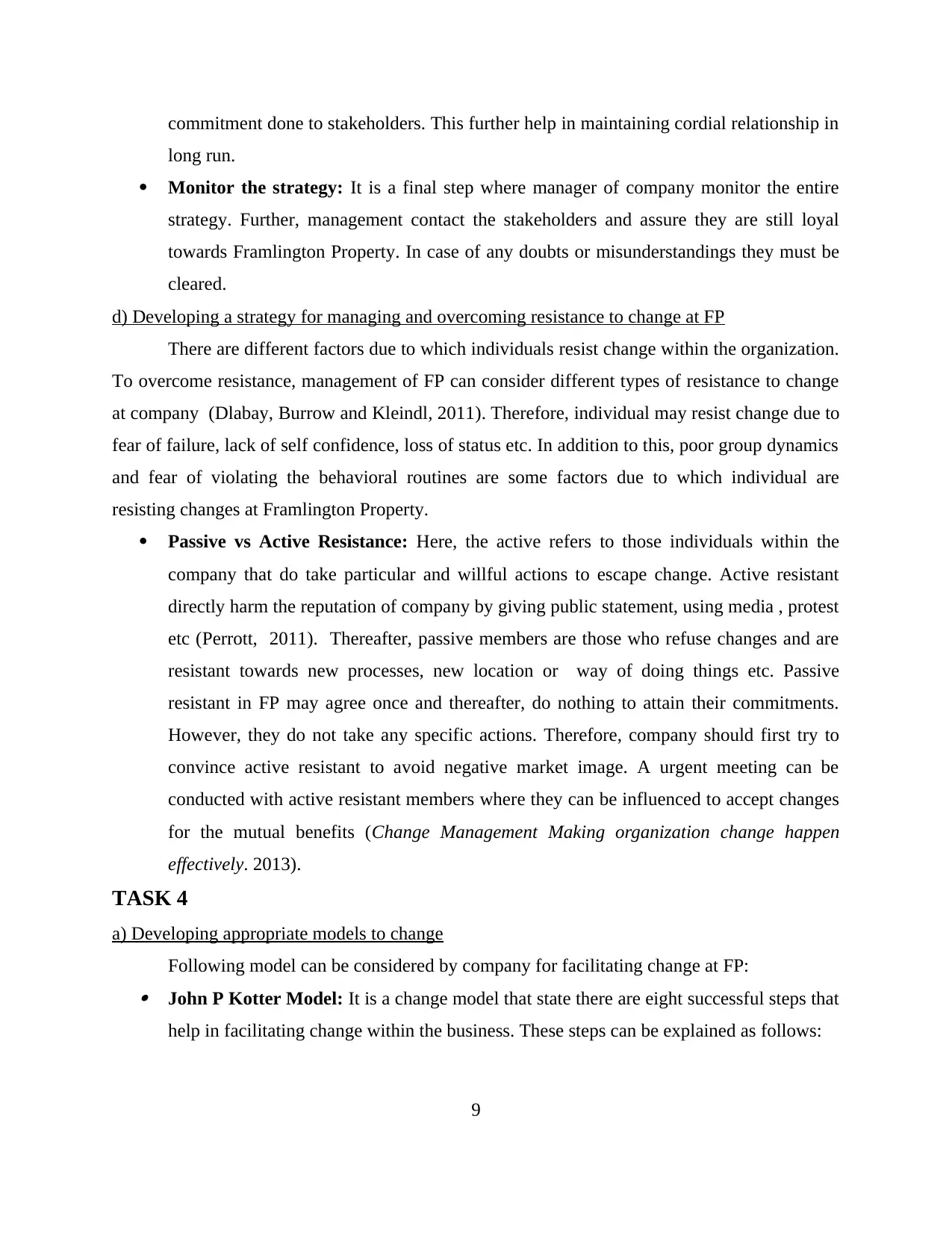
commitment done to stakeholders. This further help in maintaining cordial relationship in
long run.
Monitor the strategy: It is a final step where manager of company monitor the entire
strategy. Further, management contact the stakeholders and assure they are still loyal
towards Framlington Property. In case of any doubts or misunderstandings they must be
cleared.
d) Developing a strategy for managing and overcoming resistance to change at FP
There are different factors due to which individuals resist change within the organization.
To overcome resistance, management of FP can consider different types of resistance to change
at company (Dlabay, Burrow and Kleindl, 2011). Therefore, individual may resist change due to
fear of failure, lack of self confidence, loss of status etc. In addition to this, poor group dynamics
and fear of violating the behavioral routines are some factors due to which individual are
resisting changes at Framlington Property.
Passive vs Active Resistance: Here, the active refers to those individuals within the
company that do take particular and willful actions to escape change. Active resistant
directly harm the reputation of company by giving public statement, using media , protest
etc (Perrott, 2011). Thereafter, passive members are those who refuse changes and are
resistant towards new processes, new location or way of doing things etc. Passive
resistant in FP may agree once and thereafter, do nothing to attain their commitments.
However, they do not take any specific actions. Therefore, company should first try to
convince active resistant to avoid negative market image. A urgent meeting can be
conducted with active resistant members where they can be influenced to accept changes
for the mutual benefits (Change Management Making organization change happen
effectively. 2013).
TASK 4
a) Developing appropriate models to change
Following model can be considered by company for facilitating change at FP: John P Kotter Model: It is a change model that state there are eight successful steps that
help in facilitating change within the business. These steps can be explained as follows:
9
long run.
Monitor the strategy: It is a final step where manager of company monitor the entire
strategy. Further, management contact the stakeholders and assure they are still loyal
towards Framlington Property. In case of any doubts or misunderstandings they must be
cleared.
d) Developing a strategy for managing and overcoming resistance to change at FP
There are different factors due to which individuals resist change within the organization.
To overcome resistance, management of FP can consider different types of resistance to change
at company (Dlabay, Burrow and Kleindl, 2011). Therefore, individual may resist change due to
fear of failure, lack of self confidence, loss of status etc. In addition to this, poor group dynamics
and fear of violating the behavioral routines are some factors due to which individual are
resisting changes at Framlington Property.
Passive vs Active Resistance: Here, the active refers to those individuals within the
company that do take particular and willful actions to escape change. Active resistant
directly harm the reputation of company by giving public statement, using media , protest
etc (Perrott, 2011). Thereafter, passive members are those who refuse changes and are
resistant towards new processes, new location or way of doing things etc. Passive
resistant in FP may agree once and thereafter, do nothing to attain their commitments.
However, they do not take any specific actions. Therefore, company should first try to
convince active resistant to avoid negative market image. A urgent meeting can be
conducted with active resistant members where they can be influenced to accept changes
for the mutual benefits (Change Management Making organization change happen
effectively. 2013).
TASK 4
a) Developing appropriate models to change
Following model can be considered by company for facilitating change at FP: John P Kotter Model: It is a change model that state there are eight successful steps that
help in facilitating change within the business. These steps can be explained as follows:
9
⊘ This is a preview!⊘
Do you want full access?
Subscribe today to unlock all pages.

Trusted by 1+ million students worldwide
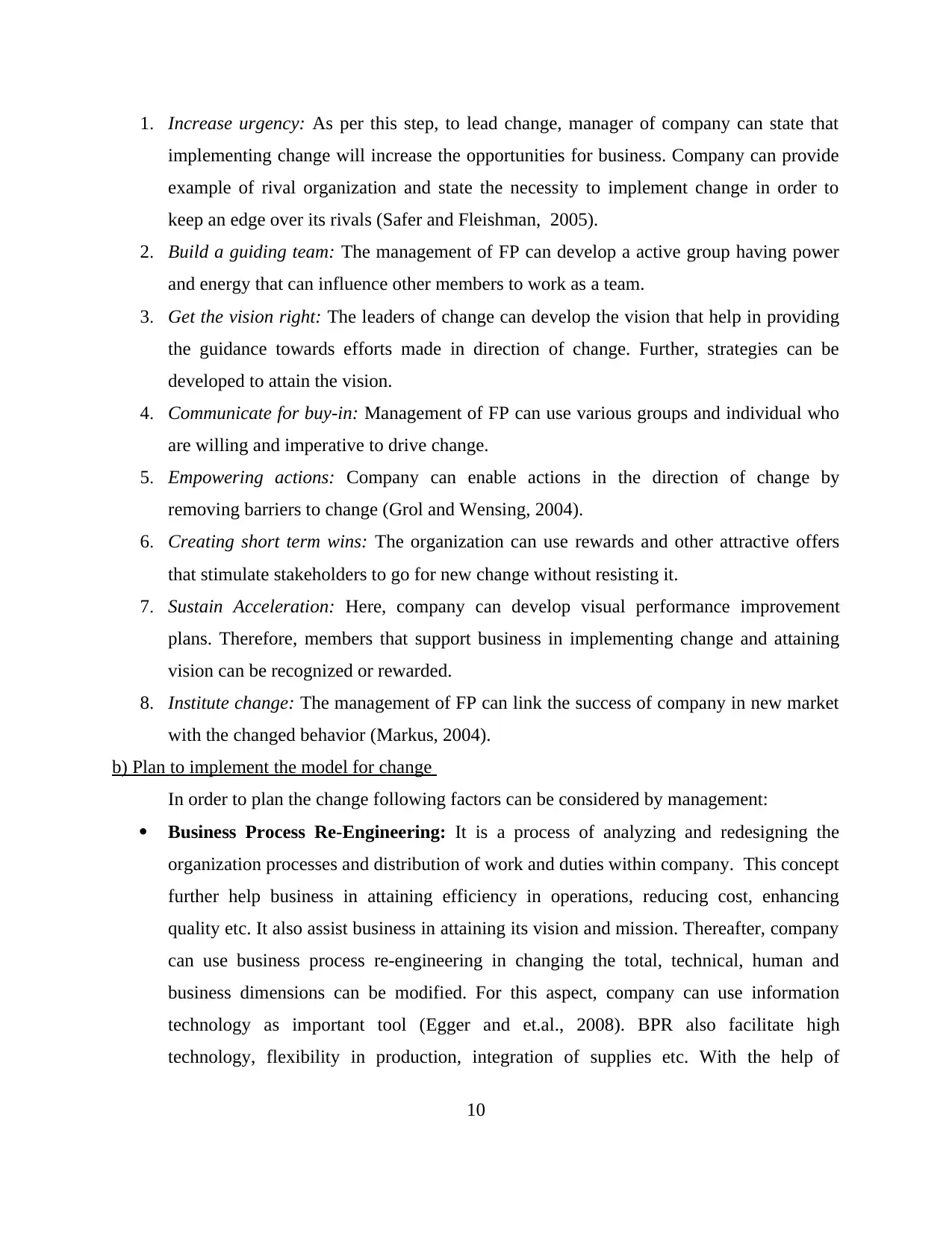
1. Increase urgency: As per this step, to lead change, manager of company can state that
implementing change will increase the opportunities for business. Company can provide
example of rival organization and state the necessity to implement change in order to
keep an edge over its rivals (Safer and Fleishman, 2005).
2. Build a guiding team: The management of FP can develop a active group having power
and energy that can influence other members to work as a team.
3. Get the vision right: The leaders of change can develop the vision that help in providing
the guidance towards efforts made in direction of change. Further, strategies can be
developed to attain the vision.
4. Communicate for buy-in: Management of FP can use various groups and individual who
are willing and imperative to drive change.
5. Empowering actions: Company can enable actions in the direction of change by
removing barriers to change (Grol and Wensing, 2004).
6. Creating short term wins: The organization can use rewards and other attractive offers
that stimulate stakeholders to go for new change without resisting it.
7. Sustain Acceleration: Here, company can develop visual performance improvement
plans. Therefore, members that support business in implementing change and attaining
vision can be recognized or rewarded.
8. Institute change: The management of FP can link the success of company in new market
with the changed behavior (Markus, 2004).
b) Plan to implement the model for change
In order to plan the change following factors can be considered by management:
Business Process Re-Engineering: It is a process of analyzing and redesigning the
organization processes and distribution of work and duties within company. This concept
further help business in attaining efficiency in operations, reducing cost, enhancing
quality etc. It also assist business in attaining its vision and mission. Thereafter, company
can use business process re-engineering in changing the total, technical, human and
business dimensions can be modified. For this aspect, company can use information
technology as important tool (Egger and et.al., 2008). BPR also facilitate high
technology, flexibility in production, integration of supplies etc. With the help of
10
implementing change will increase the opportunities for business. Company can provide
example of rival organization and state the necessity to implement change in order to
keep an edge over its rivals (Safer and Fleishman, 2005).
2. Build a guiding team: The management of FP can develop a active group having power
and energy that can influence other members to work as a team.
3. Get the vision right: The leaders of change can develop the vision that help in providing
the guidance towards efforts made in direction of change. Further, strategies can be
developed to attain the vision.
4. Communicate for buy-in: Management of FP can use various groups and individual who
are willing and imperative to drive change.
5. Empowering actions: Company can enable actions in the direction of change by
removing barriers to change (Grol and Wensing, 2004).
6. Creating short term wins: The organization can use rewards and other attractive offers
that stimulate stakeholders to go for new change without resisting it.
7. Sustain Acceleration: Here, company can develop visual performance improvement
plans. Therefore, members that support business in implementing change and attaining
vision can be recognized or rewarded.
8. Institute change: The management of FP can link the success of company in new market
with the changed behavior (Markus, 2004).
b) Plan to implement the model for change
In order to plan the change following factors can be considered by management:
Business Process Re-Engineering: It is a process of analyzing and redesigning the
organization processes and distribution of work and duties within company. This concept
further help business in attaining efficiency in operations, reducing cost, enhancing
quality etc. It also assist business in attaining its vision and mission. Thereafter, company
can use business process re-engineering in changing the total, technical, human and
business dimensions can be modified. For this aspect, company can use information
technology as important tool (Egger and et.al., 2008). BPR also facilitate high
technology, flexibility in production, integration of supplies etc. With the help of
10
Paraphrase This Document
Need a fresh take? Get an instant paraphrase of this document with our AI Paraphraser
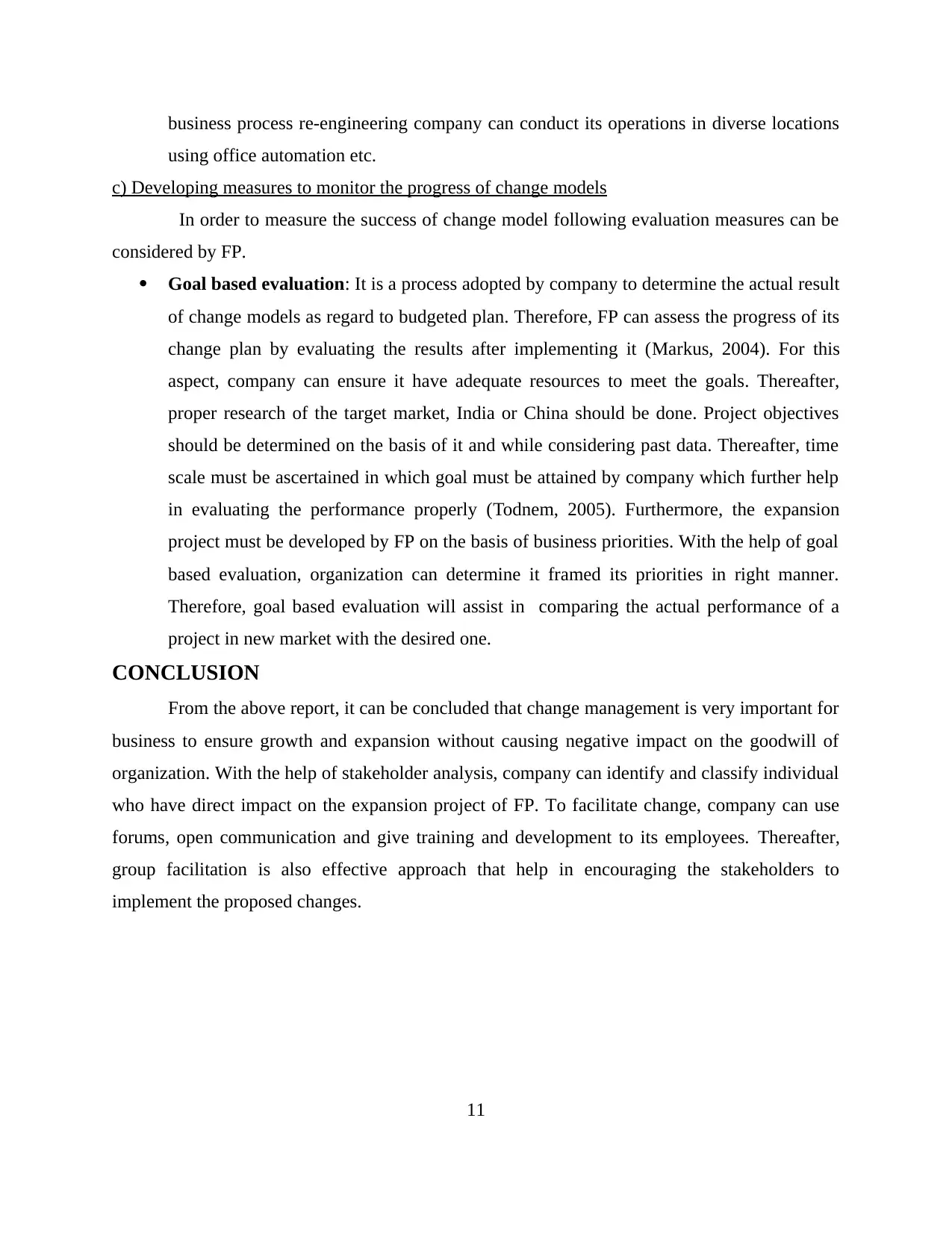
business process re-engineering company can conduct its operations in diverse locations
using office automation etc.
c) Developing measures to monitor the progress of change models
In order to measure the success of change model following evaluation measures can be
considered by FP.
Goal based evaluation: It is a process adopted by company to determine the actual result
of change models as regard to budgeted plan. Therefore, FP can assess the progress of its
change plan by evaluating the results after implementing it (Markus, 2004). For this
aspect, company can ensure it have adequate resources to meet the goals. Thereafter,
proper research of the target market, India or China should be done. Project objectives
should be determined on the basis of it and while considering past data. Thereafter, time
scale must be ascertained in which goal must be attained by company which further help
in evaluating the performance properly (Todnem, 2005). Furthermore, the expansion
project must be developed by FP on the basis of business priorities. With the help of goal
based evaluation, organization can determine it framed its priorities in right manner.
Therefore, goal based evaluation will assist in comparing the actual performance of a
project in new market with the desired one.
CONCLUSION
From the above report, it can be concluded that change management is very important for
business to ensure growth and expansion without causing negative impact on the goodwill of
organization. With the help of stakeholder analysis, company can identify and classify individual
who have direct impact on the expansion project of FP. To facilitate change, company can use
forums, open communication and give training and development to its employees. Thereafter,
group facilitation is also effective approach that help in encouraging the stakeholders to
implement the proposed changes.
11
using office automation etc.
c) Developing measures to monitor the progress of change models
In order to measure the success of change model following evaluation measures can be
considered by FP.
Goal based evaluation: It is a process adopted by company to determine the actual result
of change models as regard to budgeted plan. Therefore, FP can assess the progress of its
change plan by evaluating the results after implementing it (Markus, 2004). For this
aspect, company can ensure it have adequate resources to meet the goals. Thereafter,
proper research of the target market, India or China should be done. Project objectives
should be determined on the basis of it and while considering past data. Thereafter, time
scale must be ascertained in which goal must be attained by company which further help
in evaluating the performance properly (Todnem, 2005). Furthermore, the expansion
project must be developed by FP on the basis of business priorities. With the help of goal
based evaluation, organization can determine it framed its priorities in right manner.
Therefore, goal based evaluation will assist in comparing the actual performance of a
project in new market with the desired one.
CONCLUSION
From the above report, it can be concluded that change management is very important for
business to ensure growth and expansion without causing negative impact on the goodwill of
organization. With the help of stakeholder analysis, company can identify and classify individual
who have direct impact on the expansion project of FP. To facilitate change, company can use
forums, open communication and give training and development to its employees. Thereafter,
group facilitation is also effective approach that help in encouraging the stakeholders to
implement the proposed changes.
11
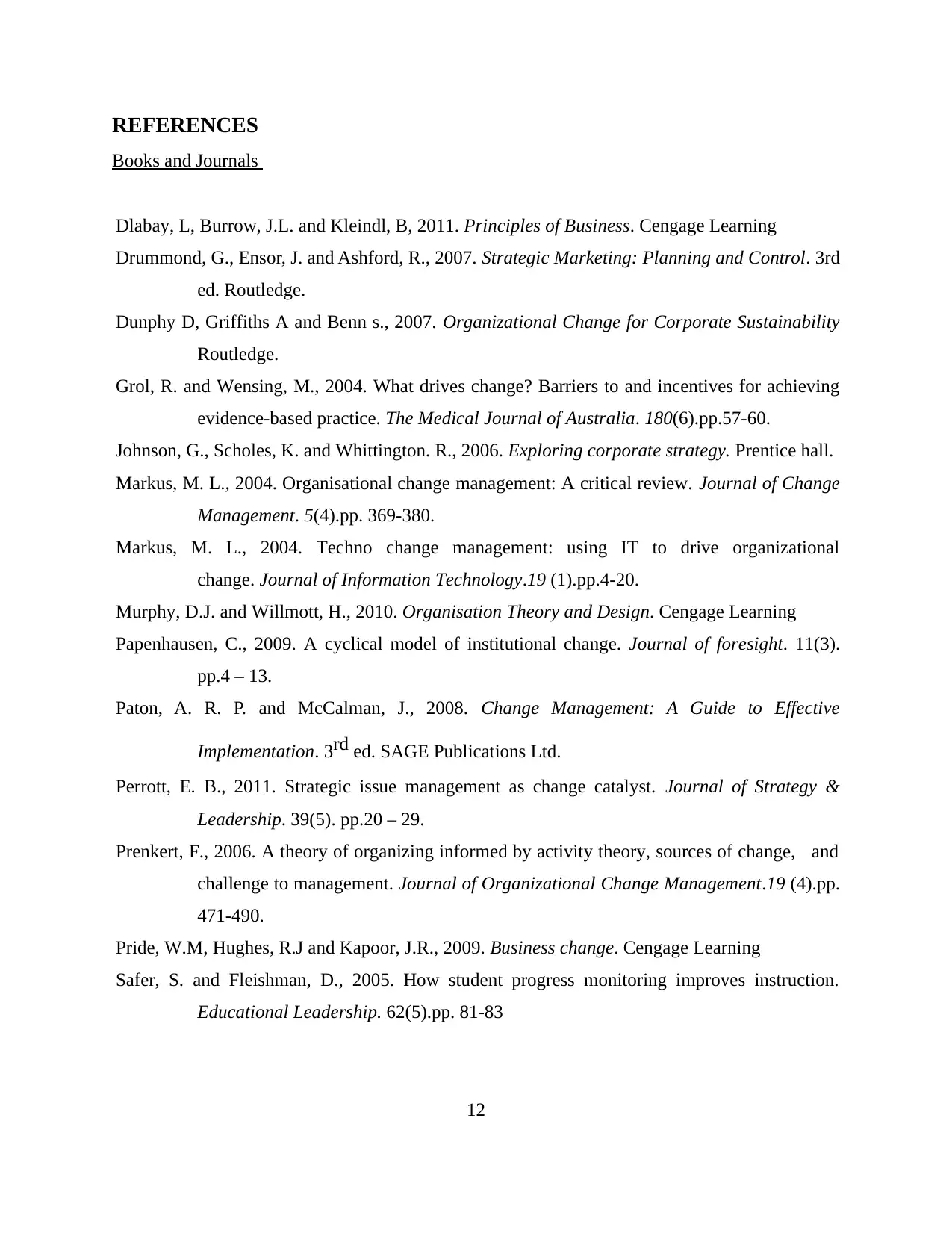
REFERENCES
Books and Journals
Dlabay, L, Burrow, J.L. and Kleindl, B, 2011. Principles of Business. Cengage Learning
Drummond, G., Ensor, J. and Ashford, R., 2007. Strategic Marketing: Planning and Control. 3rd
ed. Routledge.
Dunphy D, Griffiths A and Benn s., 2007. Organizational Change for Corporate Sustainability
Routledge.
Grol, R. and Wensing, M., 2004. What drives change? Barriers to and incentives for achieving
evidence-based practice. The Medical Journal of Australia. 180(6).pp.57-60.
Johnson, G., Scholes, K. and Whittington. R., 2006. Exploring corporate strategy. Prentice hall.
Markus, M. L., 2004. Organisational change management: A critical review. Journal of Change
Management. 5(4).pp. 369-380.
Markus, M. L., 2004. Techno change management: using IT to drive organizational
change. Journal of Information Technology.19 (1).pp.4-20.
Murphy, D.J. and Willmott, H., 2010. Organisation Theory and Design. Cengage Learning
Papenhausen, C., 2009. A cyclical model of institutional change. Journal of foresight. 11(3).
pp.4 – 13.
Paton, A. R. P. and McCalman, J., 2008. Change Management: A Guide to Effective
Implementation. 3rd ed. SAGE Publications Ltd.
Perrott, E. B., 2011. Strategic issue management as change catalyst. Journal of Strategy &
Leadership. 39(5). pp.20 – 29.
Prenkert, F., 2006. A theory of organizing informed by activity theory, sources of change, and
challenge to management. Journal of Organizational Change Management.19 (4).pp.
471-490.
Pride, W.M, Hughes, R.J and Kapoor, J.R., 2009. Business change. Cengage Learning
Safer, S. and Fleishman, D., 2005. How student progress monitoring improves instruction.
Educational Leadership. 62(5).pp. 81-83
12
Books and Journals
Dlabay, L, Burrow, J.L. and Kleindl, B, 2011. Principles of Business. Cengage Learning
Drummond, G., Ensor, J. and Ashford, R., 2007. Strategic Marketing: Planning and Control. 3rd
ed. Routledge.
Dunphy D, Griffiths A and Benn s., 2007. Organizational Change for Corporate Sustainability
Routledge.
Grol, R. and Wensing, M., 2004. What drives change? Barriers to and incentives for achieving
evidence-based practice. The Medical Journal of Australia. 180(6).pp.57-60.
Johnson, G., Scholes, K. and Whittington. R., 2006. Exploring corporate strategy. Prentice hall.
Markus, M. L., 2004. Organisational change management: A critical review. Journal of Change
Management. 5(4).pp. 369-380.
Markus, M. L., 2004. Techno change management: using IT to drive organizational
change. Journal of Information Technology.19 (1).pp.4-20.
Murphy, D.J. and Willmott, H., 2010. Organisation Theory and Design. Cengage Learning
Papenhausen, C., 2009. A cyclical model of institutional change. Journal of foresight. 11(3).
pp.4 – 13.
Paton, A. R. P. and McCalman, J., 2008. Change Management: A Guide to Effective
Implementation. 3rd ed. SAGE Publications Ltd.
Perrott, E. B., 2011. Strategic issue management as change catalyst. Journal of Strategy &
Leadership. 39(5). pp.20 – 29.
Prenkert, F., 2006. A theory of organizing informed by activity theory, sources of change, and
challenge to management. Journal of Organizational Change Management.19 (4).pp.
471-490.
Pride, W.M, Hughes, R.J and Kapoor, J.R., 2009. Business change. Cengage Learning
Safer, S. and Fleishman, D., 2005. How student progress monitoring improves instruction.
Educational Leadership. 62(5).pp. 81-83
12
⊘ This is a preview!⊘
Do you want full access?
Subscribe today to unlock all pages.

Trusted by 1+ million students worldwide
1 out of 13
Related Documents
Your All-in-One AI-Powered Toolkit for Academic Success.
+13062052269
info@desklib.com
Available 24*7 on WhatsApp / Email
![[object Object]](/_next/static/media/star-bottom.7253800d.svg)
Unlock your academic potential
Copyright © 2020–2025 A2Z Services. All Rights Reserved. Developed and managed by ZUCOL.





